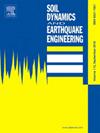Rapid and automated seismic design of cable restrainer for simply supported bridges crossing fault rupture zones using explainable machine learning
IF 4.2
2区 工程技术
Q1 ENGINEERING, GEOLOGICAL
引用次数: 0
Abstract
Earthquakes in recent decades have demonstrated that fault-crossing simply supported bridges were susceptible to damage caused by the fault-induced permanent ground dislocation. Cable restrainer can potentially reduce the relative displacement of bridge spans, but the current seismic design method for restrainer is time-consuming and labor-intensive. This study aims to develop a rapid and automated seismic design method for cable restrainer using explainable machine learning (ML) models. To do this, a large database was first generated based on the current design approach. ML algorithms were utilized to develop classification models to determine the design classes and then regression models to estimate the restrainer stiffness for the fault-crossing bridges. Furthermore, SHapley Additive exPlanations (SHAP) analysis was utilized to provide interpretations for the best regression model. In particular, an empirical formula and two explainable prediction models by combining the empirical formula with simplified ML models were finally proposed to facilitate the design for engineers. Results show that the proposed design method can provide accurate and robust results of bridge restrainers. Within the method, artificial neural network was selected among nine ML models, because of its highest accuracy for both classification and regression. The SHAP analysis reveals that, the allowable displacement has a negative nonlinear effect, while permanent ground dislocation and initial relative displacement present positive nonlinear effects. The proposed empirical formula for restrainer design can provide conservative estimations with an accuracy of 79 %, whereas the proposed explainable prediction models have a high accuracy of 94 % and are significantly efficient and user-friendly.
利用可解释的机器学习,为跨越断层破裂带的简支桥梁快速自动设计缆索约束装置
近几十年来发生的地震表明,跨越断层的简支桥梁很容易受到断层引起的永久地表位移的破坏。拉索约束装置有可能减少桥跨的相对位移,但目前的约束装置抗震设计方法耗时耗力。本研究旨在利用可解释的机器学习(ML)模型,开发一种快速、自动化的缆索约束抗震设计方法。为此,首先根据当前的设计方法生成了一个大型数据库。利用 ML 算法开发分类模型来确定设计类别,然后利用回归模型来估算跨断层桥梁的约束刚度。此外,还利用 SHapley Additive exPlanations(SHAP)分析法为最佳回归模型提供解释。特别是,通过将经验公式与简化的 ML 模型相结合,最终提出了一个经验公式和两个可解释的预测模型,以方便工程师进行设计。结果表明,所提出的设计方法可以为桥梁约束装置提供准确、稳健的结果。在该方法中,人工神经网络在分类和回归方面都具有最高的准确性,因此在九个 ML 模型中被选中。SHAP 分析表明,容许位移具有负非线性效应,而永久地面错位和初始相对位移则具有正非线性效应。所提出的约束装置设计经验公式可以提供保守的估计,准确率为 79%,而所提出的可解释预测模型的准确率高达 94%,并且非常高效和易于使用。
本文章由计算机程序翻译,如有差异,请以英文原文为准。
求助全文
约1分钟内获得全文
求助全文
来源期刊

Soil Dynamics and Earthquake Engineering
工程技术-地球科学综合
CiteScore
7.50
自引率
15.00%
发文量
446
审稿时长
8 months
期刊介绍:
The journal aims to encourage and enhance the role of mechanics and other disciplines as they relate to earthquake engineering by providing opportunities for the publication of the work of applied mathematicians, engineers and other applied scientists involved in solving problems closely related to the field of earthquake engineering and geotechnical earthquake engineering.
Emphasis is placed on new concepts and techniques, but case histories will also be published if they enhance the presentation and understanding of new technical concepts.
 求助内容:
求助内容: 应助结果提醒方式:
应助结果提醒方式:


